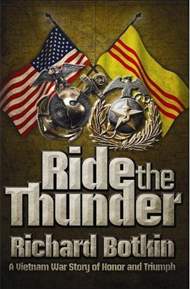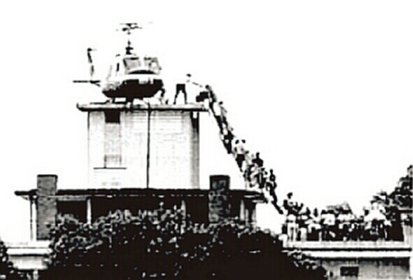35 Years After Fall of Saigon
By Richard Botkin
© 2010
Thirty five years ago this Friday, the final chapter to the American portion of the Vietnam War was ingloriously concluded – even though American combat forces were largely gone by late 1971 and all remaining support troops, air crews and POWs were home in early 1973. Unlike Dec. 7, 1941, or June 6, 1944, or Aug. 15, 1945 (Victory over Japan Day), or any other notable day from World War II, April 30, 1975, will never be recalled in positive ways by those old enough to remember or those too young whose ideas have instead been shaped by contemporary media.
For the more than three million American servicemen who honorably served in Southeast Asia between 1964 and 1973, there were no tumultuous homecoming parades, no victory celebrations in Times Square or any town square – nothing. For the remaining 200 million Americans alive then who did not go to Vietnam, the war was mostly a vicarious, unpleasant inconvenience. Where Americans might recall this day in 1975, if they recall it at all, they are likely to conjure tension-filled images of action at the U.S. Embassy in Saigon, of Marines attempting to impose order from chaos, of throngs of Vietnamese clamoring to get aboard already overcrowded helicopters hoping to leave ahead of the invading communists, some of those same helicopters later being pushed over the sides of U.S. Navy ships, of barely seaworthy, ramshackle hobo freighters packed to the gunwales with star-crossed refugees steaming well in trace of the American armada. As negative as it all seemed, as bad as the day was, at least the bad dream that was, for Americans, the Vietnam "experience" was ending. Time to move on.
For the left-behind 17 million citizens of the Republic of Vietnam, which ceased to exist the moment the U.S. Navy's Seventh Fleet retired over the eastern horizon, memories of that day are far different. While April 30, 1975, really did signal the conclusion of American involvement, all that changed for our discarded former allies was the manner of struggle and degree of difficulty. There would be no moving on. The new communist masters would impose a different kind of peace. It would be peace with retribution, peace with subjugation, peace with no forgiveness and peace with maximum pain. America's investment in Vietnam was significant. Aside from the tens of billions of dollars spent to fight the war, 58,000 men paid the ultimate price. Several times that number were wounded, and every man who endured combat has been marked forever by that experience.
While Americans have spent liberally and invested tremendous amounts of blood and sweat and treasure in the defense of freedom around the world, there is still that solipsistic sense, even today, perhaps especially today, that liberty is somehow an American concept and not everyone is ready to enjoy its blessings. Underappreciated is the fact that a high percentage of people who live under totalitarian rule, if given opportunity, will risk everything to seek and gain the freedoms most of us so casually take for granted.
As Richard Nixon observed in a speech given long after his retirement: "No event in American history is more misunderstood than the Vietnam War. It was misreported then. It is misremembered now." Arguably, most misreported and most misremembered is the post-Tet of 1968 time period of the war, and the media treatment of the Vietnamese effort to fight their own battles as the American drawdown continued. Misremembered and misreported are the facts that our Vietnamese allies, with the assistance of American airpower, had largely defeated the northern invaders during the Easter Offensive of 1972. Snatched from the jaws of victory, American negotiators traded away hard-fought battlefield gains for empty communist promises while Congress later turned the fiscal screws to our allies when victory, or at least freedom from northern domination, might have been theirs.
The South Vietnamese paid an especially heavy price for being the American lapdogs and lackeys they were accused of being by many in the media, the northern communists and anti-war American college students. In the military of the Republic of Vietnam, more than 220,000 men were killed in action and more than a million were wounded. Civilians, of course, paid an even higher price with more than 1.5 million killed – the highest percentages killed by the communists during their final invasion in 1975. The number of wounded and displaced civilians, many times the number killed, will never be accurately assessed. Where American expenditure of blood and treasure in Vietnam ended on April 30, 1975, for our ex-allies the nightmare had only begun. No records of the calculated retribution have been made public – even though some probably exist as the communists are known to be fastidious record keepers – but once the freedom genie was brutally forced back into her bottle, the paybacks began immediately and in earnest. Hundreds and hundreds of thousands of Vietnamese citizens, of the millions already displaced, before they had opportunity to attempt escape were consigned to Stalinist reeducation camps where many died horrible painful, slow, lonely deaths. Those who managed to survive will carry those scars to their graves.
In a 2,000-year-old village-centric and ancestor-venerating culture, it is not possible to quantify or overstate the pain of the northern conquest. The second major exodus of Vietnamese citizens within a single generation was set to begin. (In 1954 with the partitioning of Vietnam into North and South, more than 1 million northerners – about 6 percent of the population there – moved south to escape from the communists. Only a handful of the most hard-core communists moved from the South to the North.) Between 1975 and 1990 it is estimated that more than 3 million of the remaining 17 million South Vietnamese – more than one in six citizens – became "boat people" in this second diaspora. Of those who risked the high seas in anything that would float to gain their freedom, it is believed that as many as 25 percent perished. For those who made it to friendly shores, stories of rape, murder, pillage and even cannibalism perpetrated by the ubiquitous pirates are so common as to be almost the norm.
With all the pain and suffering the war in Vietnam caused, it is important to focus on the gain, and gain there was. The American and free-Vietnamese effort in Vietnam, however flawed the outcome, did buy time for the rest of Asia's economies to grow free of the communist threat. The dominoes were kept upright. Lee Kwan Yew, founding prime minister of Singapore, was perhaps most strident in his observations at the conclusion of the Vietnam War: "It was the Americans who stopped the Chinese and Vietnamese communists from spreading insurgency into Cambodia and Thailand . . . Because Americans were resolutely anti-communist and prepared to confront them, Nehru, Nasser and Sukarno could afford to be nonaligned."
Vigorous free-market economies throughout all of Asia today, in part, owe their successes to the American and free-Vietnamese blood investment that blunted what otherwise then might have been an unstoppable communist juggernaut. Investors the world over who now, without a thought, profitably invest billions in the emerging markets might ponder what the face of Asia would look like had Americans not shown up in force in the 1960s to stand beside a people who really were hoping to live outside of communist domination.
For the Vietnamese living in free countries who paid significantly for their freedom, there is no way to wipe away the pain endured. While never to be excused or forgotten, there is little positive emotion invested in self-pity or victimhood. For the American Vietnamese community, success is the best revenge. The unintended consequence of the Vietnamese loss and their ultimate migration has become their new country's gain. In California, where there are large Vietnamese populations, one can visit any of the several U.C. campuses to find young Vietnamese men and women over-represented in every professional school and program. It is said that the two million Vietnamese in the United States have a greater combined income than what is produced in the entire country of Vietnam.
On this upcoming 35th anniversary of our end to that war, we must honor our dead – American and South Vietnamese – and those left among us who nobly served. We must recall that freedom has a tremendous price which is nearly always unevenly borne, and celebrate all that was right with our effort to advance its cause.
The true history, the final history, the not-misremembered or misreported history of the Vietnam War, remains to be learned by most. That victory might have been attained is a lesson requiring further and ongoing study. From the left we have heard: "No more Vietnams." From the right, we must answer in kind: "No more Vietnams."
 Richard Botkin is a former Marine infantry officer and the author of Ride the Thunder: A Vietnam War Story of Honor and Triumph Richard Botkin is a former Marine infantry officer and the author of Ride the Thunder: A Vietnam War Story of Honor and Triumph . In the book, Botkin tells the heroic story of a few American and Vietnamese Marines who fought brilliantly and turned the tide of the Vietnam War, only to have policymakers surrender the battlefield. . In the book, Botkin tells the heroic story of a few American and Vietnamese Marines who fought brilliantly and turned the tide of the Vietnam War, only to have policymakers surrender the battlefield.
We are grateful for his permission to reprint the article above.
| 






 Richard Botkin is a former Marine infantry officer and the author of
Richard Botkin is a former Marine infantry officer and the author of 
New! Comments
Join our conversation! Leave me a comment about this page in the box below. If your comment is about another page on this site, please leave your comment on that page, because I have no ability to move it to the correct page. Thanks!